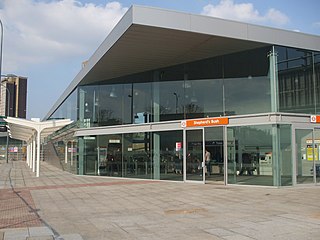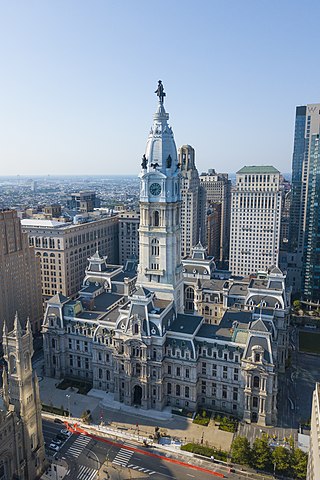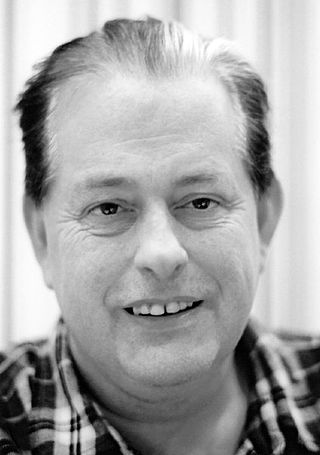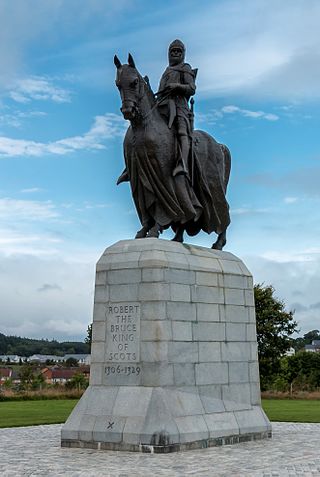
The Parthenon is a former temple on the Athenian Acropolis, Greece, that was dedicated to the goddess Athena during the fifth century BC. Its decorative sculptures are considered some of the high points of classical Greek art, an enduring symbol of Ancient Greece, democracy and Western civilization.

White City is a district of London, England, in the northern part of Shepherd's Bush in the London Borough of Hammersmith and Fulham, 5 miles (8 km) west-northwest of Charing Cross. White City is home to Television Centre, White City Place, Westfield London and Loftus Road, the home stadium of Queens Park Rangers F.C. The district got its name from the white marble cladding used on buildings during several exhibitions when the area was first developed, between 1908 and 1914.

Guildhall is a municipal building in the Moorgate area of the City of London, England. It is off Gresham and Basinghall streets, in the wards of Bassishaw and Cheap. The current building dates from the 15th century; however documentary evidence suggests that a guildhall had existed at the site since at least the early 12th century. The building has been used as a town hall for several hundred years, and is still the ceremonial and administrative centre of the City of London and its Corporation. It should not be confused with London's City Hall, the administrative centre for Greater London. The term "Guildhall" refers both to the whole building and to its main room, which is a medieval great hall. It is a Grade I-listed building.

Bowling Green is a small, historic, public park in the Financial District of Lower Manhattan, New York City, at the southern end and address origin of Broadway. Once located next to the site of the original Dutch fort of New Amsterdam, it served as a public gathering place and under the English was designated as a park in 1733. It is the oldest public park in New York City and is surrounded by its original 18th-century fence. The park included an actual bowling green and a monumental equestrian statue of King George III prior to the American Revolutionary War. Pulled down during the revolution, the 4000-pound statute is said to have been melted for ammunition to fight the British.

Fair Park is a recreational and educational complex in Dallas, Texas, United States, located immediately east of downtown. The 277-acre (112 ha) area is registered as a Dallas Landmark and National Historic Landmark; many of the buildings were constructed for the Texas Centennial Exposition in 1936.

Philadelphia City Hall is the seat of the municipal government of the City of Philadelphia in the U.S. state of Pennsylvania. Built in the ornate Second Empire style, City Hall houses the chambers of the Philadelphia City Council and the offices of the Mayor of Philadelphia.

Television Centre (TVC), alternatively BBC Studioworks Television Centre, is a building complex in White City, West London, which was the headquarters of BBC Television between 1960 and 2013. After a refurbishment, the complex reopened in 2017 with three studios in use for TV production, operated by BBC Studioworks. The first BBC staff moved into the Scenery Block in 1953, and the centre was officially opened on 29 June 1960. It is one of the most readily recognisable facilities of its type, having appeared as the backdrop for many BBC programmes. Parts of the building are Grade II listed, including the central ring and Studio 1.

The Chicago Cultural Center, opened in 1897, is a Chicago Landmark building operated by Chicago's Department of Cultural Affairs and Special Events. The Cultural Center houses the city's official reception venue, where the Mayor of Chicago has welcomed presidents, royalty, diplomats, and community leaders. It is located in the Loop, across Michigan Avenue from Millennium Park.

TheArts Centre Te Matatiki Toi Ora is a hub for arts, culture, education, creativity and entrepreneurship in Christchurch, New Zealand. It is located in the Gothic Revival former Canterbury College, Christchurch Boys' High School and Christchurch Girls' High School buildings, many of which were designed by Benjamin Mountfort. The centre is a national landmark and taonga as it is home to New Zealand's largest collection of category one heritage buildings with 21 of the 23 buildings covered by Heritage New Zealand listings.

Lake Grace is a town in the eastern Wheatbelt region of Western Australia, 345 kilometres (214 mi) from Perth along State Route 107 between Wagin and Ravensthorpe. It is the main town in the Shire of Lake Grace. At the 2016 census, Lake Grace had a population of 507.

Rupert William Penry-Jones is a British actor, known for his performances as Adam Carter in Spooks, Clive Reader in Silk, DI Joseph Chandler in Whitechapel, and Mr. Quinlan in the American horror series The Strain.

Martyn Ware is an English musician, composer, arranger, record producer, and music programmer. As a founding member of both the Human League and Heaven 17, Ware co-wrote hit songs such as "Being Boiled" and "Temptation".

Hélio Oiticica was a Brazilian visual artist, sculptor, painter, performance artist, and theorist, best known for his participation in the Neo-Concrete Movement, for his innovative use of color, and for what he later termed "environmental art", which included Parangolés and Penetrables, like the famous Tropicália. Oiticica was also a filmmaker and writer.

The Victoria Memorial is a large marble monument dedicated to Queen Victoria, the Empress of India (1876-1901) facing the Queens Way on the Maidan in Central Kolkata. It was built between 1906 and 1921 by the British Raj.

Walter Gilbert (1871–1946) was an English sculptor. He first studied at Birmingham Municipal School of Art and then the National Art Training School, now the Royal College of Art. After a short career as an instructor, Gilbert worked at the Bromsgrove Guild, where he was a director, and then at H.H. Martyn & Co. While at the Guild, Gilbert collaborated with Louis Weingartner. When he had moved over to H.H. Martyn, his son, Donald Gilbert, was also employed by the firm, and father and son collaborated on many works. He retired in 1940 and died six years later.

Exeter Bridge is a bridge in the centre of Derby spanning the River Derwent 200 metres south of the more modern Cathedral Green Footbridge.

The Pavillon Le Corbusier is a Swiss art museum in Zürich-Seefeld at Zürichhorn dedicated to the work of the Swiss architect Le Corbusier. In 1960, Heidi Weber had the vision to establish a museum designed by Le Corbusier. The building was to exhibit his works of art in an ideal environment created by the architect himself. It was then named the Centre Le Corbusier or Heidi Weber Museum. In April 2014 the building and museum went over to the city of Zürich, and was renamed in May 2016.

The Horses of Helios, also known as The Four Bronze Horses of Helios, is a bronze sculpture of four horses by Rudy Weller. It is one half of a commission installed in 1992 when the adjacent Criterion Theatre was refurbished. The other half, the Daughters of Helios or Three Graces, is a sculpture of three women leaping off the building six stories above.
Thomas Bayliss Huxley-Jones was a British sculptor known for creating several public works for British towns and cities.

The equestrian statue of Robert the Bruce at the Bannockburn Visitor Centre, Bannockburn, Stirling, is a 1964 work by Pilkington Jackson.



















